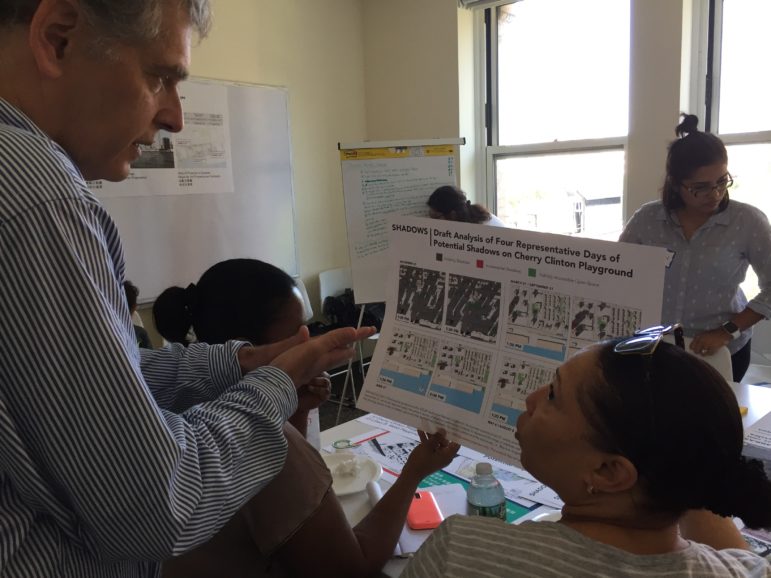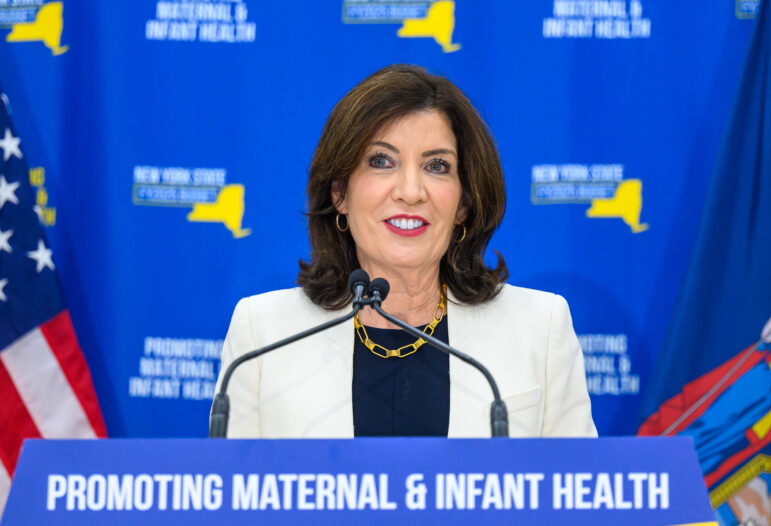
Abigal Savitch-Lew
Residents and David Karnovsky, a lawyer contracted by the developers to complete the environmental review, discuss the potential impact of the new towers on shadowing .
At a meeting held Saturday, Lower East Side residents were asked to consider mitigation strategies to address a variety of impacts that an upsurge of luxury high rises on the waterfront is expected to have on their neighborhood—though many residents said they’d still rather see no development to begin with.
The meeting was the final of four community engagement sessions sponsored by the three developers that plan to construct skyscrapers in the working-class neighborhood of Two Bridges. It was facilitated by Karp Strategies, the urban planning consultant contracted by the development team. The meetings, which are not officially required, are part of an agreement between city officials and the developers because of the size of the coinciding projects.
Throughout the process, residents have expressed concerns that the development will result in overcrowding, gentrification and other negative effects. (See our print newsletter in Chinese, Spanish and English on development on development issues in the Lower East Side here.)
The official document that details what impacts the three projects will have, and how they should be mitigated—known as the Draft Environmental Impact Statement—has yet to be released, but at Saturday’s meeting, Karp Strategies began to share early findings and to solicit feedback from residents on the best ways to address potential impacts.
During a discussion of the shadows that the towers might cast on local parks and playgrounds, residents were shown maps of the additional shadows that the new towers would cause, and were told that in some cases developers are required to provide funding to address such impacts. Residents were then asked what activities—from new plantings that thrive in shade, to investments in new parks—the community might prefer to use such funding for.
“Here’s the mitigation: Take the money and build somewhere else!” one resident said sarcastically, while someone else suggested that the developers should allow access to rooftop green spaces on their new buildings.
During a discussion focused on affordable housing, residents were asked to provide input on the income levels for the affordable units. All three developers have committed to setting aside at least 25 percent of the units at rent-restricted levels. They plan to apply for Affordable New York, the state tax credit formerly known as 421-a.
That tax program provides two potential sets of options for the income-levels: 25 percent of units at lower income levels, or 30 percent of units at higher income levels.
But neither option seemed like a good deal to the few participants present, who were mostly still troubled by the potential influx of what will likely be very costly apartments. (A nearby tower already under construction includes one bedroom condos priced at over $1.6 million.)
“Teach the residents how to make $1 million,” suggested Tania Castro Negron, the resident leader of the nearby housing development Lands End II.
The discussion then turned to the importance of ensuring locals receive credit counseling well before the affordable housing lottery begins, and that local organizations receive funding to help with the application process.
The developers have already offered to provide some form of credit counseling, and, voluntarily, to ensure any affordable units created under the tax credit remain permanently affordable. Residents of Community Board 3 will receive preference for 50 percent of those units.
As to whether or not the developments can be stopped altogether, the answer is not an easy one. The developments don’t need City Council approval because they already have the zoning they need (though they wouldn’t have had that zoning if the Chinatown Working Group rezoning plan had been passed, advocates of that plan point out). The developers still must go through an environmental review process and adopt any mitigation strategies that the city requires to address the impacts of the developments on the neighborhood.
However, because the developments are in a former Urban Renewal Area governed by special land restrictions, the developers do require something called a permit modification from the City Planning Commission, and that modification can only be granted if the commission concludes that the project won’t have negative impacts on things like neighborhood density and other factors.
Maureen Koetz, a lawyer working with residents, says the way to stop the project is to convince the commission that it can’t possibly make such a conclusion. But David Karnovsky, a lawyer contracted by the developers to complete the environmental impact statement, says that ultimately the developers will be able to prove that the mitigation strategies adopted will be sufficient to ensure the project won’t have negative impacts.
And, Karnovsky assured residents on Saturday, the city has ways to ensure developers comply with the mitigation strategies required. For instance, the city could tell a developer that until the nearby subway station has a new elevator, the city won’t be granting the project a certificate of occupancy.
What’s less clear, however, is whether the methods used to assess the impacts, and the mitigation strategies that the city ultimately requires from the developer will actually satisfy residents’ concerns about their neighborhood.
For instance, resident leader Castro Negron says that the city should require the developers to assess the impact of shadows not only on parks, playgrounds and churches, but on local NYCHA developments and on the health of local children. Others want the city to require the use of a larger radius when studying impacts on things like rent levels in the surrounding area.








2 thoughts on “Residents Look for Ways to Reduce the Impact of Massive New LES Skyscrapers”
Is anyone concerned about the pollution in our neighborhood or the impact on our sewer system? I can understand beautifying our neighborhood but take care of existing concerns beforehand.
What the LES needs is permanently affordable housing, not more luxury towers!